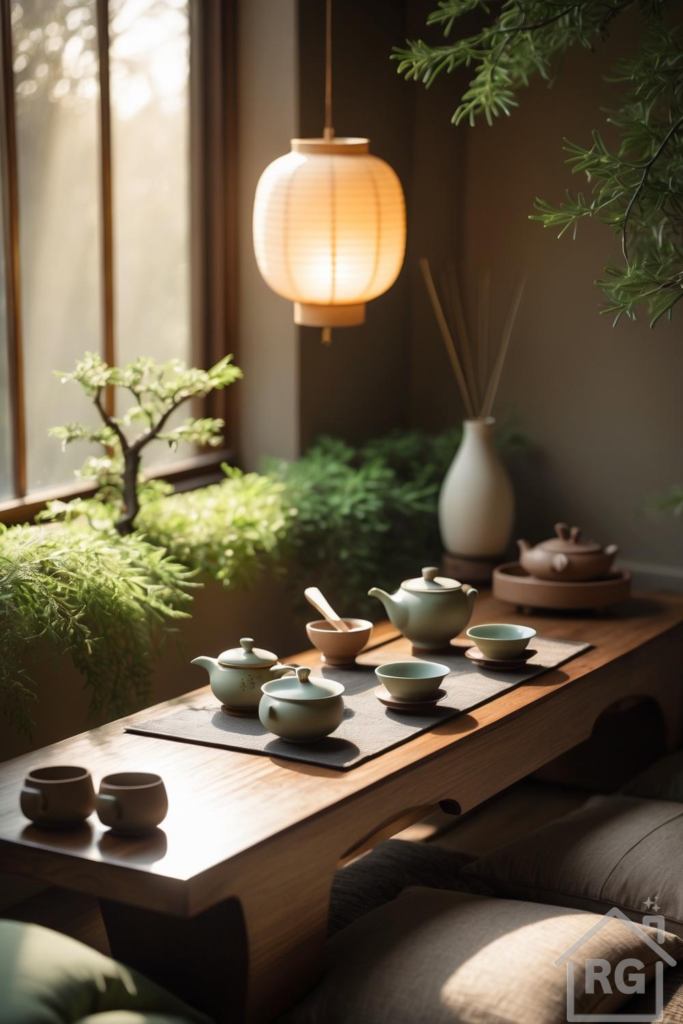
In our fast-paced modern lives, the search for a personal sanctuary, a quiet corner where one can pause and reconnect, has become more vital than ever. Imagine a space bathed in soft, diffused light, where the gentle rustle of leaves and the earthy scent of wood create an immediate sense of calm. This is the essence of a Japanese-inspired tea nook – a dedicated haven designed for mindfulness, reflection, and the simple, profound ritual of tea.
Drawing inspiration from traditional Japanese aesthetics, particularly the principles of Wabi-Sabi (finding beauty in imperfection and transience) and Zen philosophy, these spaces are characterized by their simplicity, natural materials, and a deep connection to nature. They are not merely decorative but functional, inviting you to slow down, be present, and savor the moment. Let’s delve into the elements that compose such a tranquil retreat and how you can cultivate this serene atmosphere in your own home.
The Essence of Tranquility: A Harmonious Color Palette
The foundation of any peaceful space lies in its color scheme. A Japanese-inspired tea nook embraces a palette rooted in nature, designed to soothe the senses rather than stimulate them. Think of the muted, earthy tones found in a forest or a quiet garden after rain. The dominant hues are often:
- Soft Sage Greens and Mossy Tones: These verdant shades, reminiscent of lush foliage and aged patina, bring the calming presence of nature indoors. They evoke growth, renewal, and a sense of groundedness. Imagine the gentle hue of a ceramic teapot, a soft cushion, or the vibrant life of a well-tended plant.
- Warm Browns and Rich Earth Tones: From the deep, grounding shade of a polished wooden table to the subtle warmth of the walls, browns anchor the space. They speak of stability, natural materials, and the comforting embrace of the earth. These aren’t stark, cold browns, but rather inviting, organic shades that feel lived-in and authentic.
- Creamy Whites and Soft Ivories: Used sparingly, these lighter tones provide moments of visual rest and reflect light, preventing the space from feeling too heavy. A paper lantern casting a gentle glow, or the subtle sheen of a ceramic vase, can introduce these ethereal shades, adding a touch of lightness and purity.
- Subtle Greys: Often found in natural stone or woven textiles, soft greys can act as a bridge between the warmer and cooler tones, adding depth and sophistication without overpowering the natural feel.
The key is to use these colors in a way that feels organic and harmonious, allowing them to blend seamlessly rather than creating stark contrasts. The overall impression should be one of quiet elegance and understated beauty.
Tactile Sensations: Embracing Natural Textures
Beyond color, the tactile quality of a space profoundly influences its mood. A Japanese tea nook is a symphony of natural textures, each inviting touch and contributing to a sense of authenticity and calm. Consider incorporating:
- Smooth, Polished Wood: The centerpiece of many tea nooks is a low wooden table. Whether it’s a rich walnut or a lighter oak, the grain of the wood tells a story, connecting you to the natural world. The smooth, cool surface invites you to rest your hands, grounding you in the present moment.
- Earthy Ceramic and Pottery: The tea set itself is often crafted from ceramic, with a satisfying weight and a slightly textured, unglazed finish or a smooth, matte glaze. The feel of a warm ceramic cup in your hands is an integral part of the tea ritual, enhancing the sensory experience.
- Soft, Woven Fabrics: Floor cushions, often made from natural fibers like linen, cotton, or even hemp, provide comfort and a sense of informality. Their subtle texture adds warmth and invites you to settle in, promoting a relaxed posture that encourages contemplation.
- Delicate Paper: A traditional Japanese paper lantern (Andon or Chochin) diffuses light beautifully, creating a soft, ethereal glow. The delicate translucence of the paper adds a layer of quiet elegance and a sense of tradition.
- Living Plant Foliage: The varied textures of leaves – from the delicate fronds of a fern to the sturdy branches of a bonsai – are essential. They introduce organic forms and a dynamic, living element that constantly shifts with the light.
By layering these natural textures, you create a rich, sensory environment that feels both inviting and authentic, a space that engages more than just your sight.
Mindful Furnishings: The Low Table and Seating
The furniture in a Japanese tea nook is intentionally low to the ground, a deliberate choice that fosters a sense of groundedness and intimacy. This style of seating encourages a more relaxed, contemplative posture, bringing you closer to the earth and promoting a feeling of being rooted.
- The Low Tea Table (Chabudai): This is the functional heart of the nook. Choose a table that is sturdy, made from quality wood, and has clean, simple lines. Its height allows for comfortable seating on floor cushions, making the tea ceremony or quiet work feel more intentional and less formal.
- Comfortable Floor Cushions (Zabuton): Instead of chairs, plush floor cushions provide seating. Opt for cushions with natural fabric covers in complementary earthy tones. Layering a few cushions can add extra comfort and visual interest, inviting you to sink in and relax.
- Minimalism as a Principle: Resist the urge to overfurnish. Every piece in a Japanese-inspired space serves a purpose, either functional or aesthetic, contributing to the overall sense of calm and uncluttered beauty. The empty space is as important as the objects within it, allowing the eye and mind to rest.
Illuminating Serenity: The Role of Lighting
Lighting in a tea nook is not just about visibility; it’s about creating an atmosphere. The goal is a soft, diffused glow that mimics natural light and fosters a sense of peace and introspection.
- Natural Light: Maximize natural light from windows. Sheer curtains or blinds can soften harsh sunlight, diffusing it into a gentle, ambient glow that changes throughout the day, connecting the indoor space to the rhythm of the outside world.
- The Paper Lantern: A traditional Japanese paper lantern is an iconic choice. Its translucent paper shades the bulb, casting a warm, inviting light that is soft on the eyes. Hung at an appropriate height, it becomes a focal point, radiating a comforting luminescence.
- Subtle Accent Lighting: Consider small, low-level lamps or even candles (used safely) to create pockets of warmth and intimacy in the evenings. The aim is to avoid harsh overhead lighting, opting instead for multiple, softer light sources that layer to create depth and ambiance.
The interplay of light and shadow is crucial, adding a dynamic yet subtle element to the space, enhancing its tranquil character.
Bringing Nature Indoors: The Power of Greenery
A deep connection to nature is fundamental to Japanese design. Plants are not just decorations; they are living elements that bring vitality, purify the air, and provide a constant reminder of the natural world’s beauty and cycles.
- Bonsai Trees: A miniature bonsai tree is a powerful symbol of nature, patience, and artistic cultivation. Its sculptural form and delicate leaves add a focal point of living art.
- Lush Ferns and Greenery: Surround your nook with a variety of green plants. Ferns with their delicate fronds, or other leafy plants, can create a sense of lushness and privacy, transforming the space into a verdant oasis. Arrange them at different heights to create visual interest and depth.
- Mindful Placement: Place plants where they can thrive and where their forms can be appreciated. Consider how light falls on their leaves, highlighting their textures and colors.
The presence of living plants breathes life into the tea nook, making it feel fresh, vibrant, and deeply connected to the outdoors.
Ritual & Reflection: Thoughtful Accessories
Accessories in a Japanese tea nook are chosen with intention, each contributing to the functionality and aesthetic of the space, supporting the ritual of tea and quiet contemplation.
- The Tea Set: This is paramount. Choose a ceramic tea set with a teapot, cups, and perhaps a small bowl, in a color that complements your palette – perhaps a soft sage green or an earthy brown. The design should be simple, elegant, and comfortable to hold.
- Tea Mats: Small, woven or felt mats placed under the tea set protect the table and define the space for the tea ritual, adding another layer of texture.
- Subtle Aromatics: A ceramic vase holding diffuser sticks with a calming essential oil blend (like sandalwood or cedarwood) can subtly enhance the sensory experience, adding a gentle, natural fragrance without being overpowering.
- Minimal Decor: Avoid clutter. A single, carefully chosen piece of art, a smooth river stone, or a small, meaningful object can add character without distracting from the overall tranquility. The emphasis is on quality over quantity.
Every accessory should feel purposeful, enhancing the experience of peace and presence.
Crafting Your Own Oasis: Tips for Achieving the Look
Ready to transform a corner of your home into a serene tea nook? Here are actionable tips to guide you:
- Define Your Space: Even a small corner can become a tea nook. Use a low screen, a strategically placed plant, or simply the arrangement of furniture to define its boundaries.
- Start with a Neutral Base: Begin with walls in soft, earthy tones like warm grey, muted beige, or a very light sage. This provides a calming backdrop for your natural elements.
- Invest in Quality Natural Materials: Prioritize wood, ceramic, and natural fabrics. These materials age beautifully and contribute significantly to the authentic feel.
- Embrace Low-Profile Furniture: A low table and floor cushions are key. Look for designs with clean lines and minimal ornamentation.
- Layer Your Lighting: Combine natural light with a soft, diffused light source like a paper lantern. Add small, warm accent lights if needed for evening ambiance.
- Bring in Abundant Greenery: Don’t shy away from plants. Mix sizes and types, from a delicate bonsai to lush ferns, to create a vibrant, living environment.
- Select Your Tea Set Mindfully: Choose a set that feels good in your hands and visually complements your space. It’s the heart of the tea ritual.
- Declutter Ruthlessly: A serene space is an uncluttered one. Remove anything that doesn’t serve a purpose or bring you joy. Simplicity is paramount.
- Incorporate Elements of Wabi-Sabi: Don’t strive for perfection. Embrace natural imperfections, the beauty of aged materials, and the asymmetry found in nature.
- Engage All Senses: Think about not just what you see, but what you feel (textures), hear (gentle sounds, quiet), and smell (natural scents, tea).
Conclusion
Creating a Japanese-inspired tea nook is more than just decorating a space; it’s about cultivating a mindset. It’s an invitation to slow down, to engage with the present moment, and to find beauty in simplicity and nature. By carefully selecting colors, textures, furniture, and accessories, and by embracing the principles of mindfulness and natural harmony, you can transform a simple corner into a profound sanctuary. This personal oasis will serve as a constant reminder to pause, breathe, and savor the quiet moments that nourish the soul, offering a peaceful escape from the demands of the everyday world.
